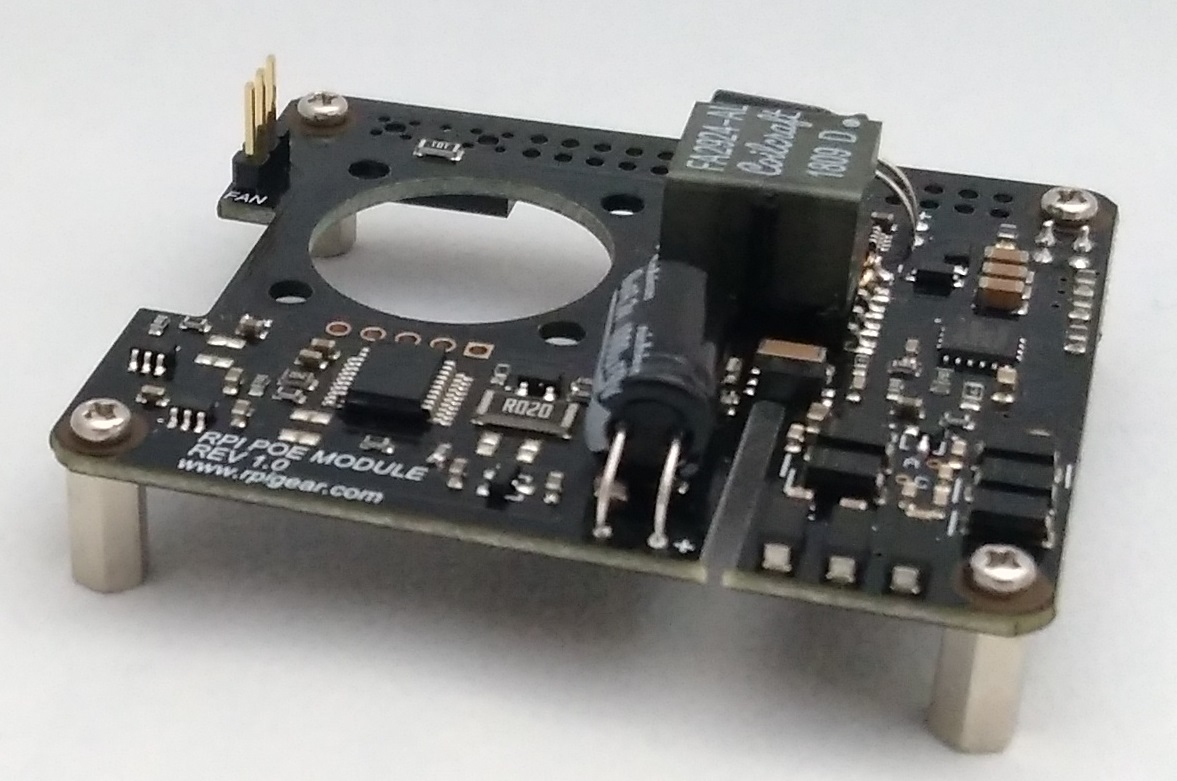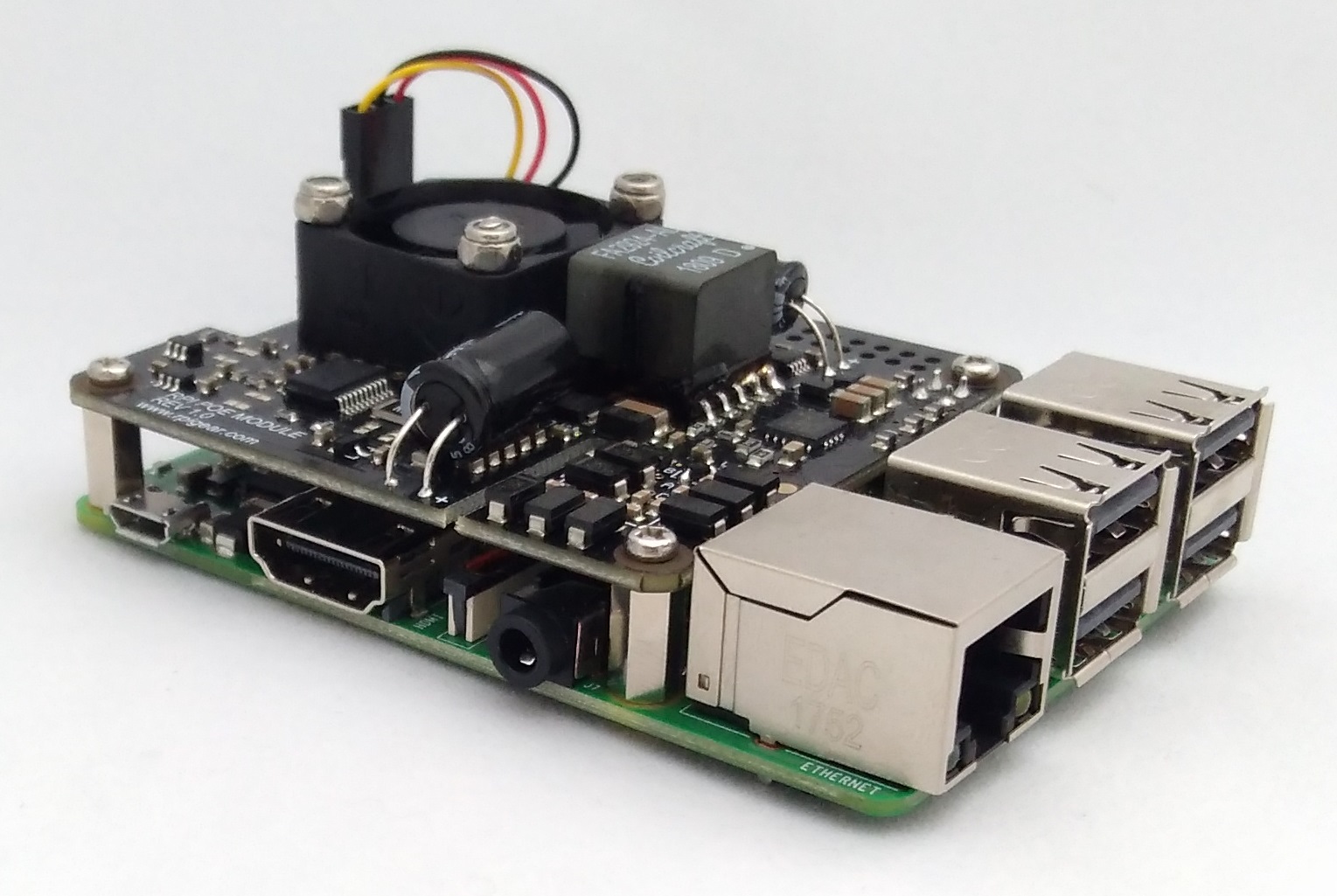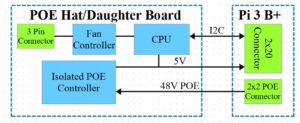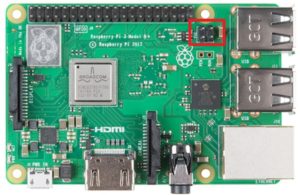!!! Only the Pi 3 B+ and Pi 4 currently support PoE !!!
Overview
A PoE (power over ethernet) solution for the Raspberry Pi 3 B+.
Main Features
-
High output current, high efficiency isolated dc/dc design
-
Multi speed fan controller with stuck rotor detection, automatic fan speed adjustment based on the Pi temperature. User can select the target temperature.
-
Full control and diagnostics with Linux commands, voltage, current, power, and temperature. Both on the Raspberry Pi side and the POE side.
-
Advanced features include the ability to power cycle the Pi remotely and a watchdog that can power cycle the Pi if it becomes unresponsive due to a software crash or similar.
-
Stackable architecture and configurable i2c address allows other boards to be stacked on top.
Downloads
Datasheet
User Manual
Quick Start Guide
Linux Software 1.0 1.1
Purchasing
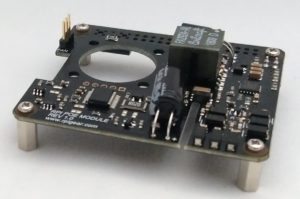
- POE Module
- Mounting Hardware(fem/fem standoffs x 4, M2.5 screw x 8)
- Note: Fan and Raspberry Pi is not included.
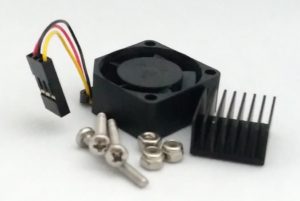
- 25mm x 25mm Sunon MagLev 5V fan with stuck rotor detection
- Mounting Hardware
- Heatsink for Raspberry Pi CPU
- Part# POE_FAN_1.0
FAQ
Which versions of the Raspberry Pi are supported ?
Pi 3 B+ and Pi 4
POE requires a new 4 pin connector that is only present on the Pi 3 B+ and Pi 4 at this time.
What type of PSE (power sourcing equipment) can I connect to ?
Any PoE capable switch or injector should work. If the Raspberry Pi will be heavily loaded then it's best to use a switch or injector capable of delivering at least 15W.
What is the power cycle command ?
The power cycle command turns power off, waits a couple of seconds, then turns it back on. After initiating a power cycle remember to call “sudo poweroff” to safetly power down the Raspberry Pi and prevent corruption of the file system.
What is the watchdog ?
If enabled, the watchdog expects the Raspberry Pi to periodically extend the timeout. If the Raspberry Pi doesn’t extend the timeout for reasons such as a software crash, then the watchdog will power cycle the Raspberry Pi automatically. This can be useful to automatically reboot high availability systems.
Do I need to put a fan ?
The fan is optional, it should not be necessary for most applications.
However it’s a good idea if the Raspberry Pi is heavily loaded and/or operating in high ambient temperatures with limited airflow. Use the -status command to monitor temperatures to help determine if a fan is needed.
What type of fan can I use ?
Please use a 5V 25mm x 25mm 3 pin fan where the third pin is stuck rotor detection. A 2 pin fan can also be used, but then the stuck rotor alarm will not work and should be disabled in the .conf file.
What is stuck rotor detection for the fan ?
The diagnostic software will show if the fan's rotors become blocked and stop spinning.
How does AUTO mode work for the fan ?
The fan controller will adjust the speed to keep the Raspberry Pi's temperature below the setpoint specified in the .conf file.
Wired ethernet doesn’t work through my POE injector ?
If the power LEDs on the Raspberry Pi comes on, but the wired ethernet doesn’t work, please try the following. This will verify that the POE injector is working.
-
Turn everything off by disconnecting power to the POE injector.
-
Disconnect the POE hat/board from the Raspberry Pi and power the Raspberry Pi from a standard USB AC/DC supply.
-
Connect the ethernet cable from the POE injector to the Raspberry Pi and see if it works
without the POE module attached. If wired ethernet still doesn’t work then the POE injector may be the cause. If possible try a 100Mbit switch instead of Gigabit one, we have seen some older 100Mbit POE injectors that don’t work at all with Gigabit switches.
